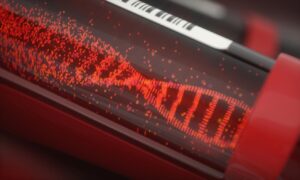
Creating DNA profiles is a complex process. About 99.9 percent of information contained in all human DNA is the same so scientists are only left with small amount of the genome to work with when developing individual unique profiles (often called DNA fingerprints). There are several methods for developing a DNA profile; STR analysis is the most common. STR analysis is also the industry standard for creating profiles uploaded to the CODIS (Combined DNA Index System) database, the FBI’s DNA index system.
STR (short tandem repeat) analysis determines a person’s DNA profile by establishing how many times a DNA sequence, called a short tandem repeat unit, appears in a chromosomal location. The chromosomal location refers to the area in a chromosome where the DNA strand resides.
Human DNA contains about 5 percent of the code responsible for traits. The rest is long nucleotide base pair stretches whose function is still not fully understood. Short tandem repeats appear as short, repetitive base pairs sequences within these stretches. Since the number of repeats in a stretch is inherited and easily identifiable, they are the perfect DNA identification markers.
Amplifying STR markers is a technique used by forensic scientists to provide investigative leads that help solve crimes. In DNA identification cases, 22+ autosomal STR locations (loci) are now used as the forensic DNA standard, and as a result, examining the 22+ loci produce a DNA profile that is essentially unique to a person (barring identical twins.) In general, when DNA profiles consist of the same alleles at these loci the probability that two unrelated individuals will have the same DNA profile, purely by chance, is very small. Typically this number is smaller than 1 over the world’s population.
Scientists also use STR analysis to identify human remains, confirm male descent lines, confirm paternity, and to study ancient human migration patterns.
The procedure of creating a DNA profile using STR analysis comprises three processes. The first is amplification, where chemical reagents are added to the extracted DNA and then heated. The heat causes the DNA molecule’s two strands to separate. The resulting individual strands can be used as templates to synthesize new DNA molecules with two strands.
The chemical reagents have markers that identify the newly duplicated DNA fragment’s start and endpoints, which are called primers. These primers are tiny DNA pieces matching highly-variable human DNA regions, stimulating the synthesis.
The primers contain fluorescent labels that lasers can identify during the testing phase. Additionally, they attach to single-stranded DNA when the chemicals and DNA begin to cool. After they bind to the copied segment’s start and endpoints, individual DNA blocks from the reagents move to fill any remaining empty places.
Scientists use a thermal cycler to heat and cool DNA. Inside the machine are wells that hold the reagents and DNA. Notably, the operator can program this machine to heat and cool the contents at given intervals. After many cycles, the process creates millions of copies of the original sample’s DNA.
Electrophoresis is the second step, where scientists sort the resulting DNA according to fragment length.
Capillary electrophoresis uses a polymer material inside a capillary tube the size of a human hair. The DNA is pulled through the capillary using an electrical current. It is mostly an automated process requiring minimal human input. A capillary electrophoresis machine works with lasers that identify fluorescent markers in the primers as the separated DNA fragments cross in front of the detector window.
The last step is interpretation. Using proprietary software, scientists can interpret results from the electrophoresis equipment. The software determines the DNA fragment sizes. Consequently, the information collected helps create DNA profiles. Further downstream software assists the scientist in deconvoluting individual contributors in complex crime scene mixtures.
These processes together become the industry standard testing procedure for DNA analysis. STR analysis will continue to play a vital role in human identity testing for the foreseeable future.
